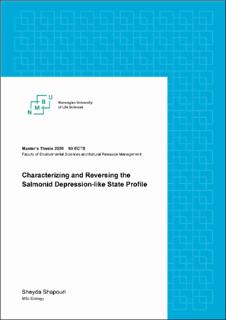| dc.description.abstract | Depressive or anxious symptoms are typically connected to chronic and unpredictable high-stress situations or otherwise adverse experiences. In aquaculture, hierarchical disputes and confrontations between individuals in dense populations are difficult to avoid or defuse as a result of the confined environment, meaning that generally submissive and reactive fish are typically chronically stressed and continually exposed to environmental stressors. Prolonged exposure to these and other stressors can result in a sustained depression-like state (DLS) that inhibits growth and social behaviors, while also reducing immune capability and greatly increasing the risk of mortality.
Chemically treating the serotonergic system of DLS fish and/or changing their social environment is theorized to stimulate interactive behaviors as well as increase interest in food, beginning the reversal of the growth stunted state. In this study, buspirone, a serotonin agonist, was used to decrease anxiety symptoms in young Atlantic salmon (Salmo salar). In addition, the environment of potential DLS fish was manipulated to try and reverse the DLS profile. The aims were to determine the exact effect of buspirone on control fish via bath treatment, manipulate the serotonergic system to reverse the DLS profile, and determine if reversal of this profile can also be achieved purely through altering their environment. To determine dosages and the appropriate method of administering buspirone to fish, a pilot study was performed on a series of healthy juvenile salmon that were experiencing temporary stress from a novel environment. This experiment showed buspirone having a clear effect on reducing stress, resulting in less socially inhibited behavior and significantly increased movement and usage of the entire water column. However, when DLS fish were treated with this same dosage, there was no change in behavior, with all fish continuing to show stress behaviors such as tight grouping and less independent movement.
While no behavioral changes were noted, buspirone treated fish had apparent higher plasma cortisol levels when sampled after acute stress confinement, as well as showing a more heterogeneous response compared to untreated fish. Meanwhile, basal (unstressed) levels remained the same for both treatments. This reversed response from DLS fish versus healthy controls could suggest an alteration in the serotonergic system in these fish affecting the reaction to serotonin agonists, possibly as a result of prolonged stress. Finally, altering the social dynamics of fish showing the DLS profile by removing larger competition and eventually transitioning them to saltwater tanks showed growth and survival rates that rivaled their non-DLS counterparts, showing that some variations of this DLS profile can be reversed. | en_US |

